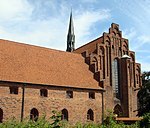M/S Maritime Museum of Denmark
1915 establishments in DenmarkBjarke Ingels buildingsHelsingørKronborgMaritime museums in Denmark ... and 1 more
Museums established in 1915

The M/S Maritime Museum of Denmark (Danish: M/S Museet for Søfart) is a maritime museum located in Helsingør, Denmark. Established in 1915, its collections cover Danish trade and shipping from the 15th century to the present day. The museum was originally located at Kronborg Castle. In 2013, the museum moved into new underground premises designed by Bjarke Ingels Group (BIG) around a former dry dock. Until 31 December 2011, the museum was known as Handels- og Søfartsmuseet (literally "The Trade and Maritime Museum"), which was officially translated as the Danish Maritime Museum.
Excerpt from the Wikipedia article M/S Maritime Museum of Denmark (License: CC BY-SA 3.0, Authors, Images).M/S Maritime Museum of Denmark
Ny Kronborgvej, Helsingør Municipality
Geographical coordinates (GPS) Address Website External links Nearby Places Show on map
Geographical coordinates (GPS)
| Latitude | Longitude |
|---|---|
| N 56.039166666667 ° | E 12.615555555556 ° |
Address
M/S Museet for Søfart
Ny Kronborgvej
3000 Helsingør Municipality
Capital Region of Denmark, Denmark
Open on Google Maps










